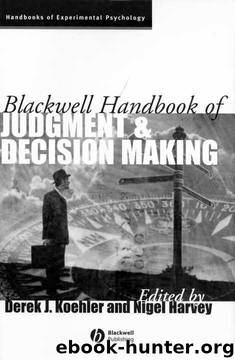Blackwell Handbook of Judgment and Decision Making by Derek J. Koehler;Nigel Harvey

Author:Derek J. Koehler;Nigel Harvey
Language: eng
Format: mobi
Published: 2007-09-23T14:01:00+00:00
Conclusion
The study of expertise in JDM is important for several reasons. At a theoretical level, we believe that the blending of naturalistic and laboratory-based research can generate a variety of lawful relationships. For example, the RPD model has led to a set of hypotheses about lawful relationships: First, that in most domains handled by experienced decision makers, most decisions will be made using recognitional strategies, rather than an analytic comparison of courses of action (Klein, 1998). Second, as people gain experience, they make more decisions relying on recognitional matches rather than comparison of courses of action (Klein, 1998). Third, for decision makers with even moderate experience, the first option they generate is usually satisfactory (Johnson & Raab, 2003; Klein, Wolf, Militello, & Zsambok, 1995). Fourth, options are more likely to be evaluated using mental simulation than by comparing the options on a generic set of criteria (Klein & Crandall, 1995). Fifth, as decision makers gain experience, they shift from spending most of their time examining options, to spending the majority of their time assessing the situation (Kobus et al., 2000). To date, the supporting evidence for these propositions comes largely from the field. Extensive laboratory research is needed to further test, refine, and possibly reject these and alternative hypotheses.
We also see great practical implications for studying expertise in JDM. It is important to understand the components of expertise to better prepare novices and less experienced individuals to become more expert and build their intuitions. Several researchers and practitioners are applying models of expertise to generate training interventions to help people acquire skill and knowledge more quickly. The goal is to move people up the learning curve at a faster rate by giving them low- and high-fidelity simulations to deliberately practice decisions and judgments. These simulations and their lessons learned help the individual form a base of experience and more complete mental models of the domain (Phillips & Battaglia, 2003; Pliske, Klinger, Hutton, Crandall, Knight, & Klein, 1997; Pliske, McCloskey, & Klein, 2001; Ross et al., 2003; US Army Research Institute, 2001). There are also many implications for Artificial Intelligence (Al) and system designers with regard to what human capabilities can and cannot be replicated by a computer. While systems are good at rule-based tasks, they cannot approximate human judgment when it comes to highly complex cognitive tasks. It is also important to know exactly what humans are capable of and how they do it, so that we can make better choices about how to design effective and acceptable systems to aid human decision making (Hutton, Miller, & Thordsen, 2003; Yates, Veinott, & Patalano, 2003).
Potentially interested JDM laboratory researchers will need to take several steps to make this happen. First, they must push beyond the most dominant experimental paradigms that are currently in fashion. This entails giving up the security and comfort that comes with further replication of old biases or striving to discover new ones. Examination of paradigms from experimental work on expertise outside the JDM area may provide a useful starting point.
Download
This site does not store any files on its server. We only index and link to content provided by other sites. Please contact the content providers to delete copyright contents if any and email us, we'll remove relevant links or contents immediately.
Rewire Your Anxious Brain by Catherine M. Pittman(18485)
Talking to Strangers by Malcolm Gladwell(13129)
The Art of Thinking Clearly by Rolf Dobelli(10137)
Mindhunter: Inside the FBI's Elite Serial Crime Unit by John E. Douglas & Mark Olshaker(9099)
Becoming Supernatural by Dr. Joe Dispenza(8035)
Change Your Questions, Change Your Life by Marilee Adams(7559)
The Road Less Traveled by M. Scott Peck(7469)
Nudge - Improving Decisions about Health, Wealth, and Happiness by Thaler Sunstein(7456)
The Lost Art of Listening by Michael P. Nichols(7357)
Mastermind: How to Think Like Sherlock Holmes by Maria Konnikova(7157)
Enlightenment Now: The Case for Reason, Science, Humanism, and Progress by Steven Pinker(7082)
Win Bigly by Scott Adams(7031)
The Way of Zen by Alan W. Watts(6448)
Daring Greatly by Brene Brown(6364)
Big Magic: Creative Living Beyond Fear by Elizabeth Gilbert(5551)
Grit by Angela Duckworth(5446)
Ego Is the Enemy by Ryan Holiday(5221)
Men In Love by Nancy Friday(5110)
Altered Sensations by David Pantalony(5001)
